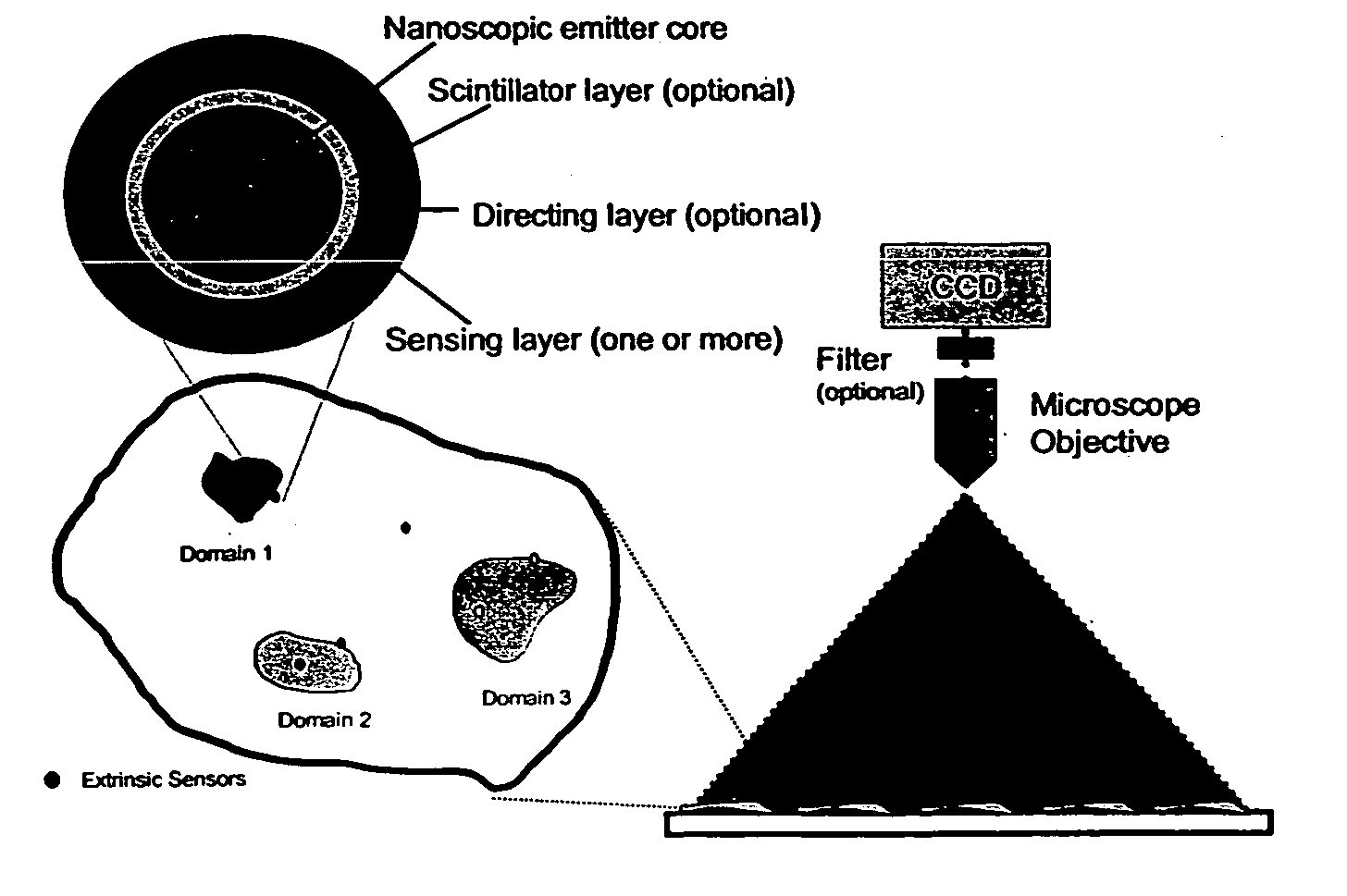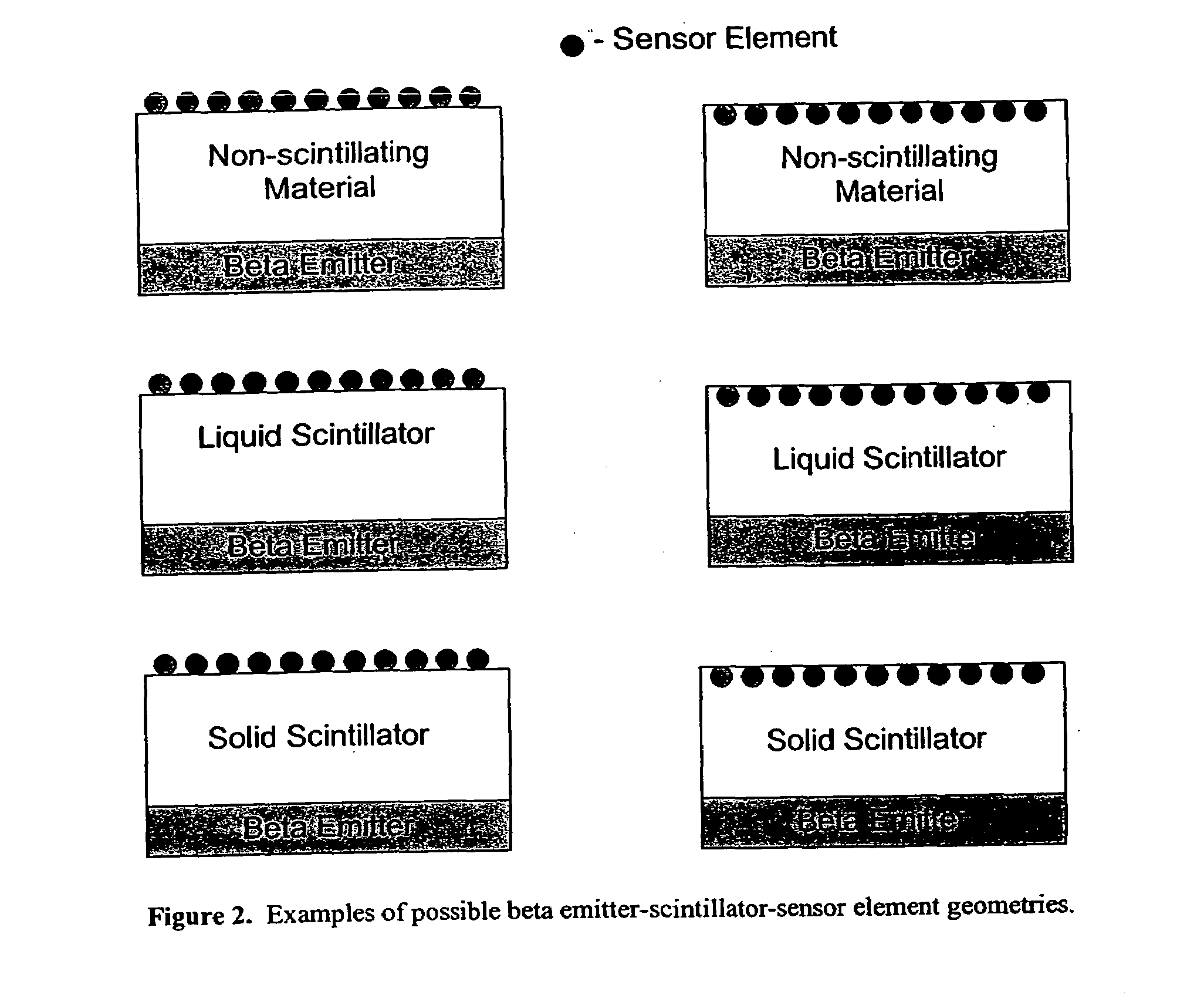Photonic sensors, xerogel-based sensors and nanosensors
a photonic sensor and nanosensor technology, applied in the field of analyte detection, can solve the problems of electrical power limit of any photonic sensor device, and achieve the effects of reducing error, improving reliability, and reducing power limi
- Summary
- Abstract
- Description
- Claims
- Application Information
AI Technical Summary
Benefits of technology
Problems solved by technology
Method used
Image
Examples
example 1
[0115]The unique nature of the beta emission yields several possible data formats from the CRNILS (FIG. 10). In FIG. 10A, results are presented where the luminescence spectrum from the sensing layer shifts in the presence of the target analyte. Potential calibration curves are presented in FIG. 11A. Curves 1-3 in FIG. 11A represent different sensing chemistries / sensing layer formulations for the same target analyte-diversification. In FIG. 10B, results are presented where the luminescence intensity from the sensing layer changes in the presence of the target analyte. Potential calibration curves are presented in FIG. 11B. Curves 1-3 in FIG. 11B represent different sensing chemistries / sensing layer formulations for the same target analyte-diversification. In FIG. 10C, results are presented where the time-resolved intensity decay profiles of the sensing layer change in the presence of the target analyte. Potential calibration curves are presented in FIG. 11C. Curves 1-3 in FIG. 11C re...
example 2
[0116]FIG. 14 presents examples of pin printed microarrays that have been formed in the laboratory. The printing solution was a 50:50 mole % tetramethylorthosilane:n-octyl-trimethoxysilane-based xerogel doped with the fluorophore rhodamine 6 G. The arrays are illuminated with a laser in an epi-fluorescence geometry, detection is with a CCD camera. The “Pulled fiber” array was formed from a single fused silica optical fiber (geometry, round, solid, points in FIG. 12). The printed feature sizes are 14±3 micrometers in diameter. Arrays are also shown for commercial quill and solid pins. In all cases, the feature size with the commercial pins is at least an order-of-magnitude larger in diameter when compared to our “Pulled fiber”. The pulled fiber can be used to increase the printed element density by 100×).
example 3
[0117]Inspection of Eqn. 1 reveals two strategies for tuning the sensitivity of any quenchometric sensor—adjust τ0 and / or adjust kq. (Note; In other sensor schemes one might tune the binding affinity, partition coefficient, etc. to generate the necessary sensor diversity.)
[0118]To illustrate the potential of this tuning we formed a diversified library of xerogel-based sensor elements for O2. Here, each sensor element is designed so that it exhibits a distinct calibration curve and / or response time course to dissolved or gaseous 02. In this particular example, these diversified xerogel-based photonic sensor libraries are derived from luminophore-doped xerogels. The xerogels are composed of n-alkyl (C1-C12)-triethoxysilane (C1-C12)-TriEOS) and tetraethyoxysilane (TEOS) or n-alkyl (C1-C12)-trimethoxysilane (C1-C12)-TriMOS) and tetramethyoxysilane (TMOS) precursors. The luminophores are tris(4.7-diphenyl-1,10-phenanthroline)ruthenium(II), [Ru(dpp)3]2+ and / or tris(2,2′-bipyridyl)rutheniu...
PUM
| Property | Measurement | Unit |
|---|---|---|
| diameter | aaaaa | aaaaa |
| size | aaaaa | aaaaa |
| sizes | aaaaa | aaaaa |
Abstract
Description
Claims
Application Information
 Login to View More
Login to View More - R&D
- Intellectual Property
- Life Sciences
- Materials
- Tech Scout
- Unparalleled Data Quality
- Higher Quality Content
- 60% Fewer Hallucinations
Browse by: Latest US Patents, China's latest patents, Technical Efficacy Thesaurus, Application Domain, Technology Topic, Popular Technical Reports.
© 2025 PatSnap. All rights reserved.Legal|Privacy policy|Modern Slavery Act Transparency Statement|Sitemap|About US| Contact US: help@patsnap.com



